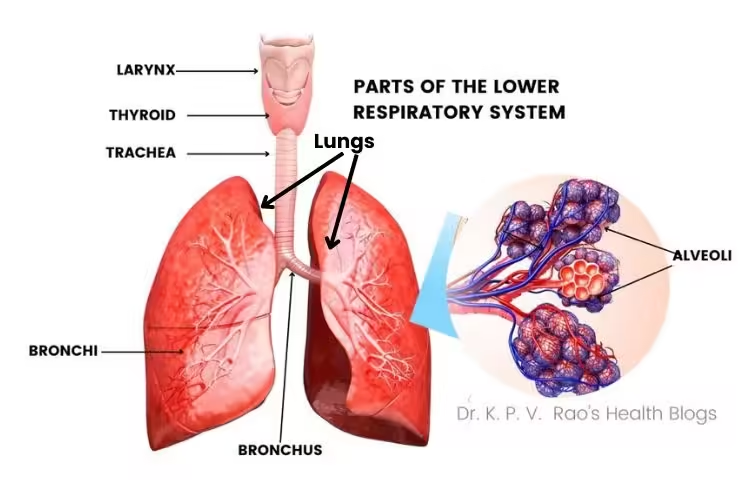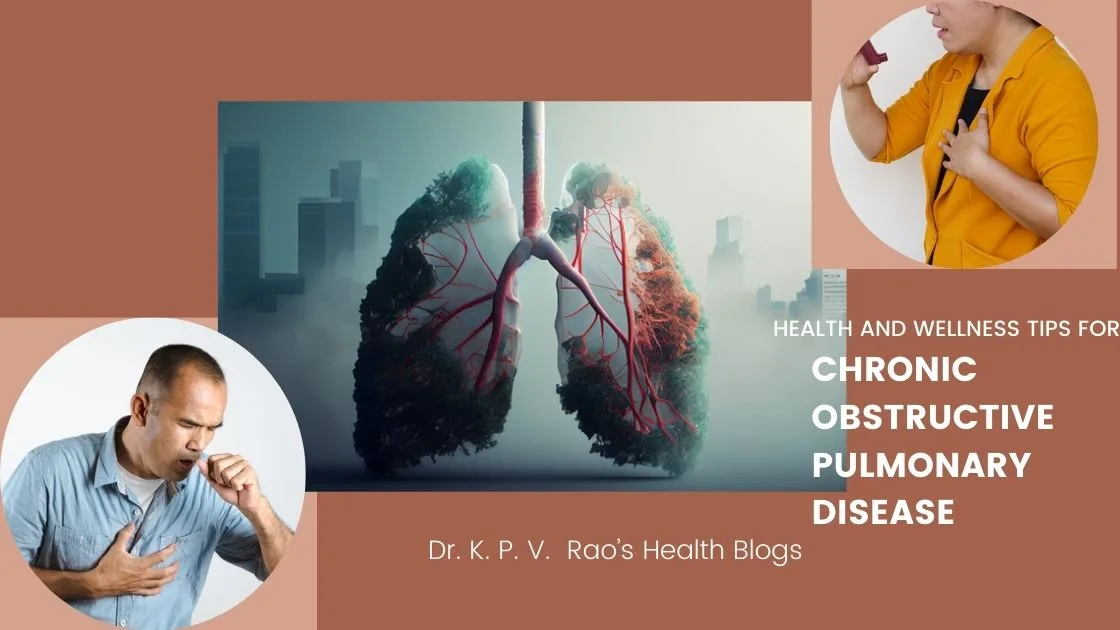Understanding Chronic Obstructive Pulmonary Disease (COPD)-: Causes, Symptoms, Treatment, and Complications
Dear friends,
Welcome to an informative article on Chronic Obstructive Pulmonary Disease (COPD). Pulmonary disease refers to the disease of the lungs and before we go ahead with understanding this disease, I want you to understand the structure of the lungs and how these parts get affected in this disease. Have a look at the image below how a typical lung looks like-

COPD involves the bronchus, bronchi and the alveoli [air sacs where exchange of gases like oxygen and carbon di oxide take place], all parts of the lungs.
Please consider supporting us by disabling your ad blocker.
I have already discussed a similar lung disorder previously- Bronchial Asthma.
In this article, we will discuss the causes, signs and symptoms, various investigations to rule out the condition, treatment options, complications if treatment is not done properly, likely health issues, and home remedies. I will also provide relevant links to further explore the topic.
Causes of Chronic Obstructive Pulmonary Disease
This is a chronic lung disease that affects millions of people worldwide. It is primarily caused by long-term exposure to harmful irritants and pollutants that damage the lungs.
The most common cause of this condition is cigarette smoking, but exposure to secondhand smoke, air pollution, and occupational hazards such as chemicals and dust can also contribute to the development of the disease.
It is important to note that not everyone who smokes or is exposed to these irritants will develop this disease. Genetic factors and individual susceptibility also play a role in determining who is more likely to develop the disease.
What happens in this ailment? The Signs and Symptoms
Chronic obstructive pulmonary disease is characterized by a range of symptoms that can vary in severity from person to person. The most common signs and symptoms include:
- Shortness of breath, especially during physical activity
- Chronic cough with or without mucus production
- Wheezing
- Tightness in the chest
- Frequent respiratory infections
- Lack of energy and fatigue
- Unintended weight loss
If you are experiencing any of these symptoms, it is important to consult a healthcare professional for a proper diagnosis.
Diagnosing the disease-Investigations
Diagnosing chronic obstructive pulmonary disease involves a series of investigations to assess lung function and rule out other possible causes of the symptoms. The most common investigations include:
- Spirometry: This test measures the amount of air you can inhale and exhale and how quickly you can do it. It helps determine the severity of airflow obstruction. Here is a detailed information on how this test is carried out-
A) Chest X-ray: This imaging test allows doctors to examine the structure of the lungs and rule out other conditions that may have similar symptoms.
B) Arterial blood gas analysis: This test measures the levels of oxygen and carbon dioxide in your blood to assess lung function and the effectiveness of breathing.
C) CT scan: A computed tomography (CT) scan provides detailed images of the lungs and can help detect emphysema, a common condition associated with COPD.
These investigations, along with a thorough medical history and physical examination, can help your healthcare professional/doctor make an accurate diagnosis of COPD.
Treatment Options for chronic obstructive pulmonary disease
While there is no cure for chronic obstructive pulmonary disease, there are various treatment options available to manage the symptoms and improve quality of life.
The treatment plan includes:
A) Lifestyle changes: Quitting smoking, avoiding exposure to irritants, and maintaining a healthy lifestyle can help slow down the progression of COPD.
B) Medications: Bronchodilators and inhaled corticosteroids are commonly prescribed to relax the airway muscles and reduce inflammation in the lungs.
C) Pulmonary rehabilitation: This program combines exercise, education, and support to help individuals with COPD improve their physical condition and learn techniques to manage their symptoms.
D) Oxygen therapy: In more severe cases, supplemental oxygen may be prescribed to improve oxygen levels in the blood.
E) Surgery: In certain cases, surgical interventions such as lung volume reduction surgery or lung transplantation may be considered.
It is important to work closely with your doctor to develop an individualized treatment plan that suits your specific needs and goals.
Complications of Untreated Chronic Obstructive Pulmonary Disease
If COPD is left untreated or not managed properly, it can lead to several complications that can significantly impact a person’s health and well-being.
Some of the complications associated with untreated COPD include:
Respiratory infections: This disease weakens the immune system and makes individuals more susceptible to respiratory infections such as pneumonia and bronchitis.
Pulmonary hypertension: It can cause high blood pressure in the arteries of the lungs, leading to heart problems and potential heart failure.
Depression and anxiety: Living with a chronic condition like COPD can take a toll on mental health, leading to increased rates of depression and anxiety.
Reduced quality of life: The symptoms of this disease can limit a person’s ability to perform daily activities, leading to a decreased quality of life.
Proper management and treatment of COPD can help reduce the risk of these complications and improve overall health outcomes.
Likely Health Issues Associated with Chronic Obstructive Pulmonary Disease
Living with Chronic Obstructive Pulmonary Disease can increase the risk of developing other health issues. Some of the likely health issues associated include:
A) Cardiovascular diseases: It is closely linked to an increased risk of cardiovascular diseases such as heart attacks and strokes.
B) Osteoporosis: It can lead to decreased bone density, increasing the risk of fractures.
C) Lung cancer: Individuals with COPD have a higher risk of developing lung cancer, especially if they continue to smoke.
D) Sleep disorders: It can cause sleep disturbances such as sleep apnea and insomnia.
It is important for individuals with COPD to be aware of these potential health issues and take steps to manage their overall health and well-being.
Home Remedies
In addition to medical treatments, there are several home remedies that can help manage the symptoms of chronic obstructive pulmonary disease and improve quality of life. However, it is important to consult with a healthcare professional before trying any home remedies. Some home remedies that may be beneficial for individuals with COPD include:
A) Quitting smoking: This is the most important step in managing COPD and slowing down its progression.
B) Regular exercise: Engaging in low-impact exercises such as walking or swimming can help improve lung function and overall fitness.
C) Eating a healthy diet: A well-balanced diet rich in fruits, vegetables, and lean proteins can provide essential nutrients to support respiratory health.
D) Staying hydrated: Drinking enough water can help thin mucus and make it easier to cough up.
E) Using a humidifier: Adding moisture to the air can help reduce coughing and ease breathing.
Remember, home remedies should be used as complementary therapies alongside medical treatments, not as a substitute for professional medical advice.
Conclusion
Chronic Obstructive Pulmonary Disease (COPD) is a chronic lung disease that requires proper management and treatment.
Understanding the causes, signs and symptoms, investigations, treatment options, complications, likely health issues, and home remedies can help individuals with COPD take control of their condition and improve their overall quality of life. If you or someone you know is experiencing symptoms of COPD, it is important to seek medical attention for an accurate diagnosis and appropriate treatment.
Useful resource:
Final Words
I hope I was able to explain COPD in a simple and informative manner. If you have understood it, please share it on various social media icons at the bottom of this article. You can also Click to Tweet here-
Learn All About Chronic Obstructive Pulmonary Disease (COPD) Share on XAdios.

